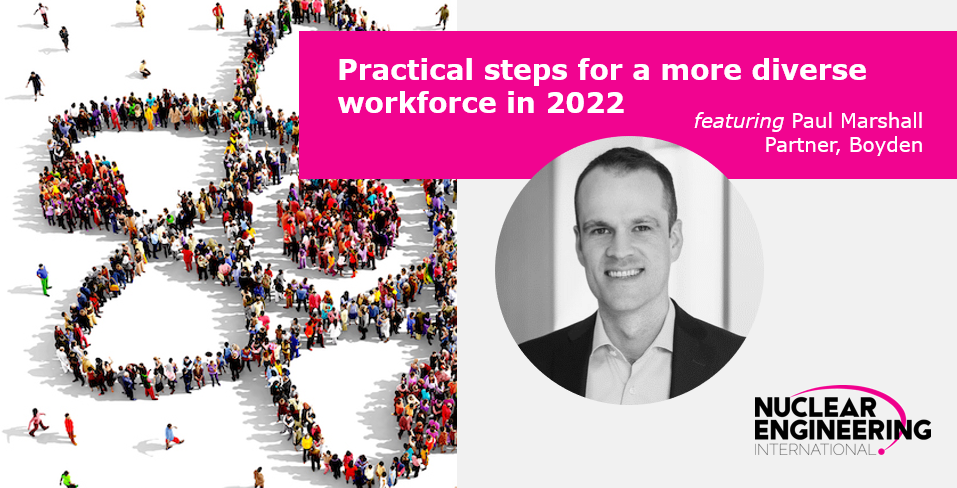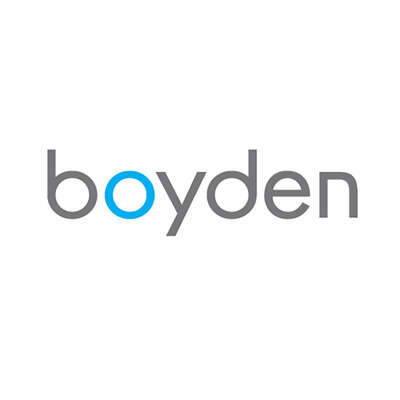Boyden’s Energy and Nuclear Recruitment Expert Paul Marshall in conversation with Nuclear Engineering International

This article was originally published by Nuclear Engineering International. Click here to view the original article.
Paul Marshall outlines a few simple ways organisations can start building greater diversity into the nuclear sector, starting in 2022.
If its profile in and around COP26 was any indication, 2021 is the year that nuclear finally made the global climate agenda. It seems the world is opening its arms to an industry that has not only been producing carbon-free electricity for decades, but is now changing the game with new, clean technologies. One of the next key challenges for the industry is to make sure the face of nuclear modernises alongside its technical progress.
Across North America, which includes two of the top nuclear generating countries (USA and Canada), Black and Indigenous people account for less than three per cent of nuclear engineers. Women make up less than 20 per cent of the nuclear sector’s workforce in Canada and less than a quarter around the world.
The industry has responded in force with global initiatives like Equal by 30 and investments in STEM programmes. These initiatives are critical and will certainly contribute to a diverse nuclear sector in the future. But, what about now?
Here are a few simple ways organisations can start building greater diversity into the sector, starting in 2022.
1. Look for talent with transferable skills
There is a common misconception that industry experience is a requirement for the job. In nuclear, that may be the case for engineering and skilled labour, but there are plenty of roles that do not require the same — or any — level of industry experience. Human resources, finance and communications are just a few of the functions where skillsets are easily transferable across industries. Casting your net wider to fill these roles means you will reach a more diverse pool of candidates.
This can also be achieved by looking at candidates in similar industries. Other players in the energy mix are obvious choices, but seek out commonalities in even broader sectors. For example, an individual who worked at an aerospace engine testing company is likely to understand decision-making in highly regulated environments — something the nuclear industry is quite familiar with.
2. Go beyond the traditional “years of experience…”
Job descriptions typically prescribe a set number of years experience as a way of assessing a candidate’s ability to do the job they are applying for. That inevitably creates a bias towards individuals who have held these roles in the past.
When designing candidate profiles, consider including components that invite lived experience or cultural competence as possible alternatives to set years of work experience. For instance, in lieu of five years work experience, would you consider two, paired with a solid understanding of the nuclear sector from a candidate who grew up in a nuclear community?
3. Build a support structure for newly appointed leaders
The process does not stop at the point-of-hire. A strong support structure is critical to the success of newly appointed leaders and their teams.
Many organisations inadvertently alienate individuals from diverse backgrounds during the onboarding process. Some signs you might be doing this? Your documentation and corporate lingo is full of industry acronyms that take years to catch on to. Your organisation isn’t talking to people about work-life balance or accommodating needs in a pandemic environment. Your new hire only met the people above them in the recruitment process. If any of that rings true, it’s time to have a fresh look at your onboarding process and consider how inclusive it truly is.
A mentorship programme comes next, whether it’s a junior employee or a senior executive. A successful mentorship programme has structure, checkpoints and sources of support centralised in the organisation.
New approach for 2022
The most important thing you can do this year is reject the notion that your organisation may have to sacrifice excellence in the pursuit of diversity. It is an outdated pattern of thinking that will not get you to a more diverse workforce and the rich benefits that enables.
Seeking out key aspects of commonality and synergy from other industries, broadening your search to include lived experience, and creating internal support structures for new leaders has the potential to change your organisation — and the nuclear industry – for the better in 2022 and beyond.

